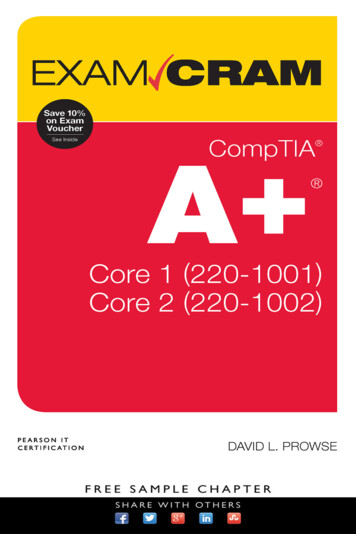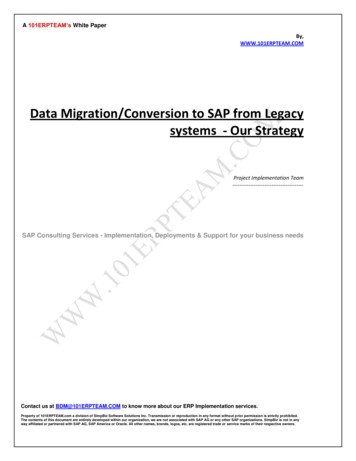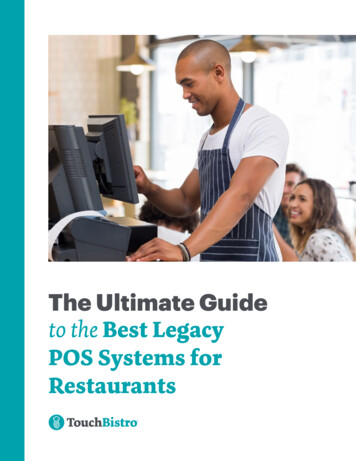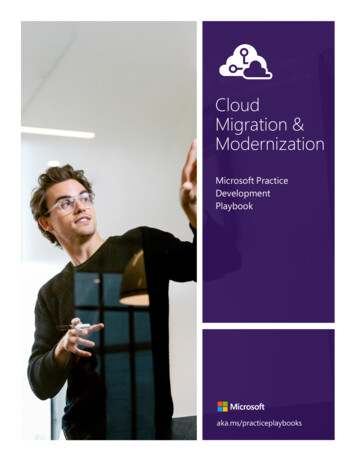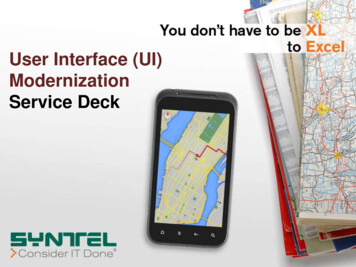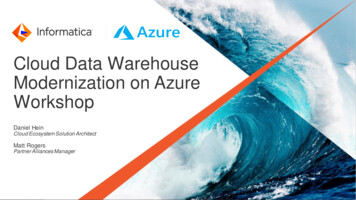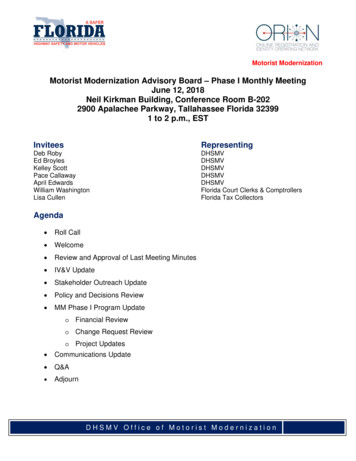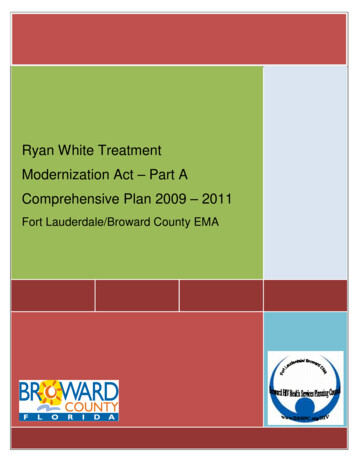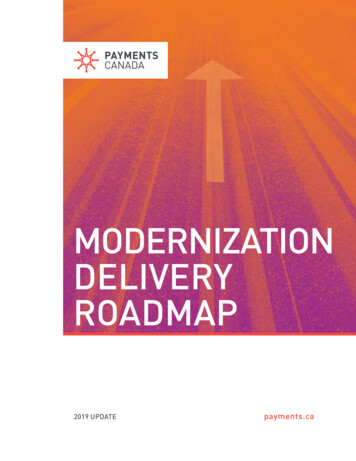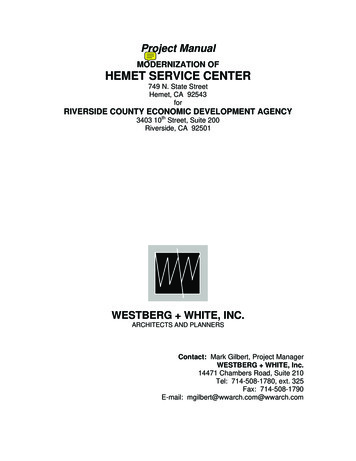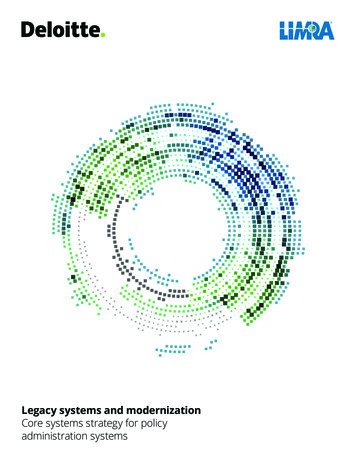
Transcription
Legacy systems and modernizationCore systems strategy for policyadministration systems
Jim GaugerManaging Director, Insurance Technology,Deloitte Consulting LLPMary M. ArtSenior Research Director, LIMRAEric SondergeldCorporate Vice President, LIMRA 2017, LL Global, Inc. All rights reserved.This publication is a benefit of LIMRA membership.No part may be shared with other organizations or reproduced in any form without Deloitte’s and LL Global’s written permission.0159-0317 (50700-10-410-24506)
Brochure / report title goes here Section title goes here ContentsExecutive summary1Why modernize?2Selecting an approach for moving forward4Where are companies on the journey?6How are companies making the journey?8Benefits: Realizing benefits takes a long time12Keys to success14Methodology162
Brochure / report title goes here Section title goes here Tables and figuresFigure 1. PAS Systems: How influential were each of the followingbusiness drivers with regard to your company’s CST strategy?3Figure 2. Considerations when making a CST target solution decision4Figure 3. Individual life insurance sales trends5Table 1. How many policy administration system (PAS) solutionsare in your ecosystem?6Figure 4. Status of legacy PAS systems7Figure 5. CST modernization approaches8Table 2. Approaches chosen and considered by companiesto achieve CST objectives9Figure 6. Estimated payback period for the benefits on CST solution:Companies with current and completed transformations12Figure 7. Have companies realized expected benefits?133
Legacy systems and modernization Core systems strategy for policy administration systemsExecutive summaryWhen faced with the economic downturnof 2008, companies focused on costcutting measures and many significantlyreduced strategic investment intechnology. As the markets and economyimproved and companies achieved bettermargins and returns on their investments,they were able to build their reserves.During the past two to three years, theseimproved economic conditions made itpossible for many life and annuity (L&A)insurers to renew their interest in strategicinvestments. As a result, modernizing andreplacing legacy systems has surfacedas a top priority for many L&A insurers.The focal point of the modernizations hasbeen the policy administration system(PAS) and the immediately surroundinginterfaces to the insurance ecosystem,like new business and underwriting, policyservices, compensations, billing andcollections, and claims.In mid-2016, Deloitte and LIMRA coauthored a survey to investigate the stateof modernization efforts by L&A insurersin the US and Canada. The goal was togain understanding and perspective ontheir efforts to simplify environments andmodernize the PAS ecosystem.This report addresses the followinginsights on core systems transformation(CST) as part of an insurance systemmodernization initiative: What are the primary business driversbehind CST initiatives? What are the key factors affecting thesolution decision criteria? How big is the legacy PAS problemand where is your organization in themodernization journey? What approaches are insurersemploying to modernize systems? How can insurer success be achieved?The insurance systems modernizationjourney can be a long and challengingendeavor. Many organizations are nowseeing the benefits of their labors. With thesharing of information comes knowledgeand the rewards of others’ experiences. Itis hoped that the best practices provided inthis report contribute to the success of yourmodernization efforts.Key points Ensure business strategy and objectivesalignment with the modernizationinitiative. Develop the business case formodernization early and socialize itoften to gain buy-in from stakeholders. Choose vendors and partners based onknowledge and experience. Have a backup plan for risk mitigation. Start small and simple and increaseprogram scope and velocity after initialsuccess. Assess the business and technologyvalue and leverage insight before makingrecommendations on the approach tomodernization. Rigorously pursue benefits to achieveexpected results: Manage to the“outcomes.” Select a strong leader with experienceand courage.1
Legacy systems and modernization Core systems strategy for policy administration systemsWhy modernize?To succeed in the long term, each projectis associated with a compelling set ofbusiness events or imperatives. Projectsas large as replacing a PAS require a strongbusiness case, socialization with keystakeholders, and alignment to the overallbusiness strategy. Ultimately, businessand technology leaders will likely commitsignificant financial and human capital to aneffort that could span several fiscal yearsand may pledge multiples of the “businessas usual” budget in a single year. The stakesare high if you fail—so why do it?Our survey canvassed L&A providers tolearn more about the primary businessdrivers for a PAS modernization (Figure1). Forty-two of the nearly 60 surveyparticipants (71 percent) are in the processof or have already completed performinga PAS modernization. Clearly, this confirmsthe focus on this business issue.Those companies currently modernizingwere subsequently asked about theinfluential business drivers impacting thedecision to begin the transformation. Wemade the following observations based onsurvey results for insurers selecting very orextremely influential business drivers:2The highest rated business driver wasproduct strategy and objectives. Eightysix percent of the respondents are lookingto bring products to market rapidlywhile simultaneously modifying productattributes as they refine the offering. Thishas been an industry focus for at least thepast decade, but now product has becomea strategic advantage. Two-thirds of the responses indicatedtechnological relevance as the secondmost selected business driver. Legacysolutions lack flexibility and carry asignificant technology debt due to datedlanguages, databases, architectures, anda limited supply of aging baby-boomerprogrammers. This liability preventsmany organizations from advancingand supporting analytics, real-timetransactions, and a digital experience. The third most selected businessdriver among respondents wasservice enablement. Digitizinginsurance operations into a paperless,automated enterprise is a focus formany organizations. Many insurers areaspiring to automate the insuranceinteractions from initial applicationcapture, underwriting, policy issue, andultimately providing a completely digitalexperience. When asked which factor was the singlemost influential business driver, one infive respondents chose product speed tomarket/policy volume growth.We also asked companies how theyexpected to “pay” for the modernization.The alignment of the business caselevers to the above business drivers wasconsistent. As to the question of benefitstargeted, the responding companiesconfirmed that product capabilities/speed to market, an improved customerexperience, and quality and access todata were essential to the growth of thebusiness in support of the business case.Each insurance company situationis different. One key is to initiate amodernization program so thebusiness strategies andobjectives align with and drivethe direction of plannedinitiatives. Modernizationprograms are not exclusivelytechnology based activities.
Legacy systems and modernization Core systems strategy for policy administration systemsFigure 1. PAS systems: How influential were each of the following business drivers with regard to yourcompany’s CST strategy?N 42, 4086%Product strategy and objectives—speed to market, distribution driven20%76%Technological relevance/risk—requiredto access enabling technologiesService enablement—digitizing services(enhanced user experience)15%69%2%52%Growth (policy/contract volumes, new markets,new distribution model, new geographies)20%52%Expense reduction13%52%Quality of systems—improveservice levels and standards13%Human capital risk—availabilityof intellectual capital13%Compliance/regulatory requirementsDivestiture, merger, or acquisitionVery or extremely influential52%50%3%7%0%Most influentialSource: LIMRA and Deloitte, 2017From an expense perspective, respondents favored three keyexpense reductions: 1) fewer operations resources (28 percent); 2)hardware/software costs (20 percent); and 3) quality improvements(20 percent). The less important need to reduce IT resourcesrepresented only 12 percent of the replies. As expected, theresource expense reduction issue has additional emotional/social implications that influence some organizations’ decision toexclude it from the business case. Concerns that businesses may beoutsourcing too much and are running operations on a shoestringbudget forsaking experience and knowledge for a low costalternative are growing. Quality improvements can be difficult toquantify if your organization does not actively measure and managequality. Ultimately, decision makers may need to be challenged,motivated, and incented to “commit” to the savings.Activities for developing the modernization businesscase should commence at the start of the project.Defining benefits in economic terms will require as muchtime as determining what to do. The business case shouldbe developed in parallel with the approach. Engage yourstakeholders early in the process. Further, socializing thebusiness case and getting buy-in with affected executiveswho will sign up for the benefits is as important as ahardened economics proposal.3
Legacy systems and modernization Core systems strategy for policy administration systemsSelecting an approach for moving forwardWhen considering the options to modernize the PAS solution,surveyed insurers nearly universally (95 percent of respondents)replied that product and servicing fit were crucial requirements(Figure 2). As the most popular requirement identified from a groupof nine options, more than half of the respondents indicated thatproduct and servicing fit was the most important selection criteriawhen looking for a PAS replacement solution. This response was notsurprising given the importance placed on product as a businessdriver for the CST initiative.Figure 2. Considerations when making a CST target solution decisionN 42, 40Insurance product/serving fit95%54%Cost of ownership83%15%Technology currency73%8%Time to implement71%13%Vendor risk68%0%59%Related capabilities—integrationwith other solutions5%37%Licensing costs0%Third-party recommendationsGlobal capabilitiesVery or extremely influentialSource: LIMRA and Deloitte, 2017427%0%10%5%Most influential
Legacy systems and modernization Core systems strategy for policy administration systemsCost of ownership, technology currency, and time to implementwere chosen as the next most important criteria when selectinga target solution. Time, cost, and technology/architectureare standard evaluation criteria to most software selectionprocesses. Today, L&A insurers are expecting lower costs thanwith their legacy mainframe environment. The technology mustreflect a reusable and portable service-oriented architecture thatwill allow micro-componentization of services over time. Vendorsare expected to demonstrate rapid, pre-configured deploymentswith robust product support and functionally-rich processingcapabilities. The state of the software industry and movement ofvendors supplying solutions to the L&A insurance industry hasbeen somewhat of a revolving door over the past two decades.All the while, the individual life insurance market is actuallycontracting, with fewer policies being issued and relatively flataverage face amounts (Figure 3).Figure 3. Individual life insurance sales trends12,000 250,00010,000 200,0008,000 150,0006,000 100,0004,000 50,0002,0000 02000 2001 2002 2003 2004 2005 2006 2007 2008 2009 2010 2011 2012 2013 2014 2015*Policies (thousands)Average size policy*Policy growth was particularly impacted by a large carrier shifting from a group to an individual platformSource: LIMRAChoose your vendors and partners carefully. Look beyond the shiny new software. Examine whether the vendor has for a trackrecord of successful implementations and a strong revenue stream to support future regulatory changes and additionalenhancements. Partner with vendors and providers possessing strong industry credentials and experience. By all means, useyour network to connect with other insurers with experience with this vendor. If you decide to take the path on the “road lesstravelled”, be sure to have a mitigation plan with business partners to help pick up the pieces.5
Legacy systems and modernization Core systems strategy for policy administration systemsWhere are companies on the journey?The urgency associated with legacy PAS modernization has beengrowing over the past five years and this research indicates thatfor at least 90 percent of respondents, this subject is top of mindfor L&A executives. The process to complete a modernization frominitial selection to the last policy converted could take a decade tocomplete depending on the staffing and capital available. The L&Arespondents reported having from one to 26 unique systems in theirpolicy administrative environments, with an average of 4.0 systemsin their ecosystem (Table 1). Those with a larger number of systemshave gotten a head start, but resolution will take years.Progress is being made with varying degrees of success to date.Before diving deep into the progress report, let’s understand thecharacteristics of the applications in scope for modernization. ThePAS application profile suggests a broad range of origins for thesource solutions. Among respondents, there are homegrown (3percent), externally developed custom solutions (20 percent) andcommercial off the shelf, or COTS (37 percent) packages. Thesesystems are generally vintage platforms, circa the 1980s and 1990s.Table 1. How many PAS solutions are in your ecosystem?All respondentsAverage numbers of systems overall4.0Median2.0Range1 to 26Source: LIMRA and Deloitte, 20176
Legacy systems and modernization Core systems strategy for policy administration systemsNearly half (46 percent) of the companies surveyed havecompleted changes and updates on at least one of theirlegacy policy administration systems (Figure 4). Of those thathave not completed a modernization yet, one quarter havea modernization underway and one in five are considering amodernization. Only nine percent of respondents do not haveany plans at this time.Roughly two in five companies (39 percent) surveyed have onelegacy PAS. Of the remaining companies, about half are attemptingtheir systems modernization at once, often seeking to complete allupdates and conversions concurrently.Those upgrading their systems separately or progressively oftenstart with their smaller systems, seeking to achieve small successesor learnings prior to tackling larger systems.Figure 4. Status of legacy PAS systemsN 5950%46%40%30%25%20%20%9%10%0%Completedat least oneAt least onein progress/nonecompletedConsidering/none completedor in progressNo plansfor anySource: LIMRA and Deloitte, 2017Regardless of where you are on the journey, it is useful to take advantage of your industry networkand trusted advisors by sharing experiences and lessons learned. The industry is at the mid-point inthe bell curve of experiences. There are still as many system modernizations yet to address as thosethat are already underway or complete. If you have many systems, start with less risky, small, andsimple blocks of business, if possible. Develop some “muscle memory” around the process since itwill likely be repeated.7
Legacy systems and modernization Core systems strategy for policy administration systemsHow are companies making the journey?One of the most difficult decisions to make with regard tomodernization is which approach to employ. In our experience,this continues to be one of the most frequently asked questionsby companies. The following graphic provides a model forcharacterizing the differences (Figure 5).The amount of change that results from modernization programsis dramatic. Some insurers prefer to tackle all solutions at once,swapping out their core administrative systems for a single largeprogram, while others march along—one system at a time—takingyears to finish.When we asked companies about their approach to modernization,half of the responses were considered nearly equally (withthe exception of consolidation, wrapper/reskin, third-partyadministration, sale of the block, and do nothing).When asked which alternatives were actually chosen,respondents centered on two most often: Convert and retire (50percent) and replace and retire (48 percent). Note, the resultsare not mutually exclusive as companies possess multiple PASand may have chosen different approaches for different systems.These favored options were followed closely by install new andupgrade existing PAS at 36 percent each.Figure 5. CST modernization approachesReplaceInstallnewRetireCore systemmodernizationoptionsRemainSource: Deloitte Consulting LLP8 Retire: To reduce the number of solutionsThe elimination of a solution as a result of a conversionof policies and/or consolidation of software applicationsPort o nothing—waitSale Resource Replace: To improve business and/or technicalvalue with a new solutionAn implementation of a new solution for futureinsurance sales with or without a conversion ofpolicies and retirement of the original softwareUpgrade/enhanceRetool Remain: No change to the current state environment Retool: To improve business and/or technicalvalue with an existing solutionA modification to the underlying application software,including languages and databases, technicalarchitecture or presentation layer of the applicationwithout a conversion Resource: To transfer responsibility and riskAn outsourcing or sale of the business as a way toeliminate/reduce ongoing accountability for managing thefuture business and technical management of the solution
Legacy systems and modernization Core systems strategy for policy administration systemsCollectively, half of the insurance system modernizations involveda new PAS solution due to the inability to maintain or sustaincurrent PAS going forward. We suspect that the business driversfor improved rapid product development capabilities, an improveddigital experience, and opportunities for growth outweigh the risksof cost and time to implement.Insurers seem equally concerned with the technology debtassociated with these legacy platforms. Even as they are planningto modernize the core systems, respondents are still concernedwith the total cost of ownership and risk associated with these agingplatforms. As indicated in the survey, system retirement weighsheavy on the minds of the executives. Half of the respondentsintend to retire a system as a result of their modernization efforts.To retire a life insurance system generally means a policy conversion.Conversion is one of the most difficult projects to provide a businesscase to justify on economic merits alone. As a result, many insurershave spent the last two or three decades trying to find a way to avoidthe dreaded “conversion.”Table 2. Approaches chosen and considered by companies to achieve CST objectiveMultiple Responses Allowed (N-42)ConsideredModernization approachNotconsideredChosenNot chosen50%26%24%Replace and retire482924Install new system363331Upgrade existing PAS363331Port to new technology293833Consolidate to the same instances191269Wrapper/reskin the solution172657Third-party administration123652Divestiture, M&A of business51086Build new system03169Convert and retire existing PASSource: LIMRA and Deloitte, 20179
Legacy systems and modernization Core systems strategy for policy administration systemsThe feedback from survey respondents is most telling. Here isa sampl
this report contribute to the success of your . record of successful implementations and a strong revenue stream to support future regulatory changes and additional enhancements. Partner with vendors and providers possessing stro
